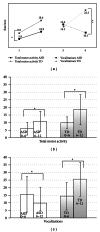Reciprocity in interaction: a window on the first year of life in autism
- PMID: 23762551
- PMCID: PMC3671510
- DOI: 10.1155/2013/705895
Reciprocity in interaction: a window on the first year of life in autism
Abstract
From early infancy onwards, young children appear motivated to engage reciprocally with others and share psychological states during dyadic interactions. Although poor reciprocity is one of the defining features of autism spectrum disorders (ASDs), few studies have focused on the direct assessment of real-life reciprocal behavior; consequently, our knowledge of the nature and the development of this core feature of autism is still limited. In this study, we describe the phenomenon of reciprocity in infant-caregiver interaction by analyzing family movies taken during the first year of life of 10 infants with ASD and 9 infants with typical development (TD). We analyzed reciprocal behaviors by means of a coding scheme developed for this purpose (caregiver-infant reciprocity scale (CIRS)). Infants with ASD displayed less motor activity during the first semester and subsequently fewer vocalizations, compared to TD infants. Caregivers of ASD infants showed in the second semester shorter periods of involvement and a reduction of affectionate touch. These results suggest that from the first months of life a nonsynchronic motor-vocal pattern may interfere in different ways with the development of reciprocity in the primary relationship between infants later diagnosed with ASD and their caregivers.
Figures



References
-
- Anderson BJ, Vietze P, Dokecki PR. Reciprocity in vocal interactions of mothers and infants. Child Development. 1977;48(4):1676–1681. - PubMed
-
- Cole T, Teboul JB. Non-zero-sum collaboration, reciprocity, and the preference for similarity developing an adaptive model of close relational functioning. Personal Relationships. 2004;11(2):135–160.
-
- Carpenter M. Just how joint is joint action in infancy? Topics in Cognitive Science. 2009;1(2):380–392. - PubMed
-
- Feldman R, Greenbaum CW. Affect regulation and synchrony in mother-infant play as precursors to the development of symbolic competence. Infant Mental Health Journal. 1997;18(1):4–23.
LinkOut - more resources
Full Text Sources
Other Literature Sources

